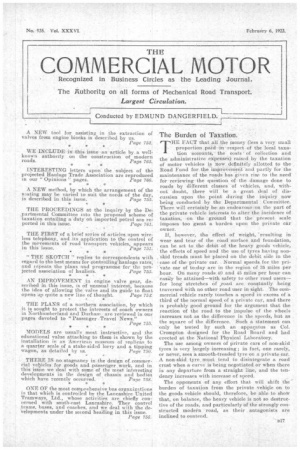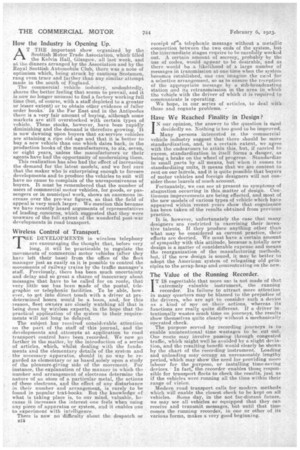.THE FACT that all the money (less a very small
Page 1

Page 2

If you've noticed an error in this article please click here to report it so we can fix it.
:proportion paid-in -respect of the local taxa
.
• tion .accounts, the costs of collection and_ • tion .accounts, the costs of collection and_ the adriiinistrative eXpenses), raised by the taxation of motor vehicles is how definitely allotted to the . Read Fund for. the imptovernent and partly for the maintenance of the roads has given rise, to the need for reviewingthe question. Of the damage done to roads by different classes -of vehicles, and, without doubt, there will be a • great deal of discussion upon the .point during' the inquiry now being conducted by the Departmental Committee. There will certainly. bean endeavourcon the part of the private vehicle interests to alter the incidence of taxation, on the'ground that the present scale imposes too great a burden 'upon the private car owner.
If, however, .the effect of weight, -resulting in wear and tear. of the roadsurface and foundation, Can be set to the debit of the heavy goods vehicle,. the effects of speed and the use of tyres having non:skid treads must be placed on the debit side in the .case.of the-privatecar. _Normal speeds for the privats car of to-day arc in the region of, 35 miles per hour. On many roa.ds.40 and 45 Miles' per hour can easily be attained—with safety to other read users— for long stretches of /road are. constantly' being traversed -With no other toad user in sight. The commercial vehicle rarely touches a speed in excess of a third of the normal speed of a private car, and there is probably good ground for the argument that the reaction of the road to the impulse of the wheels increases not as the difference iii the speeds, but as the square of the difference. Such a statement can 'only be tested by such an . a-ppatatus as Col. Crompton designed for the Road Beard and had. erected at the National Physical. Laboratory.
The use among owners of private cars of non-skid tyres is very largely increasing; in fact, one rarely, or never, sees a smooth-treaded tyre on a private cat.. ..A non-skid. tyre must tend. to disintegrate a road crust when a curve is being negotiated or when there is any departure from a straight line, and the tendency increases with increase of speed.
The opponents of any effort that will shift the burden of taxation from the private ve.hiele on to the goods vehicle should, therefore, be able to show that, on balance, the heavy vehicle is not so destructive 0f the roads, and particularly of the strongly constructed modern road, as their ..antagonists are inclined to contend.
THE COMMERCIAL MOTOR How the Industry is Opening Up.
AT THE important show organized by the Scottish Motor Trade Association, which filled the Kelvin Hall, Glasgow, all last week, and at the dinners arranged by the Association and by the Royal Scottish Automobile Club, there was a note of optimism which, being struck by cautious Scotsmen, rang even truer and farther than any similar attempt made in the south of England.
The commercial vehicle industry, undoubtedly, shares the better feeling that seems to prevail, and it is now no longer unusual to find a factory working full time (but, of course, with a staff depleted to a greater or lesser extent) or to obtain other evidence of fuller order books. In the Far East and in the Antipodes there is a very fair amount of buying, although some markets are still overstocked with certain types of vehicle. These stocks, however, have been rapidly diminishing and the demand is therefore growing. It is now dawning upon buyers that ex-service vehicles are attaining a ripe old age and that it is better to buy a new vehicle than one which dates back, in the production books of the manufacturers, to six, seven, or eight years, 'unless the manufacturers or their 'agents have had the opportunity of modernizing them. This realization has also had the effect of increasing the demand for the latest models, and we feel sure that the maker who is enterprising enough to foresee developments and to produce the vehicles to suit will have no cause to complain of the unresponsiveness of buyers. It must be remembered that the number of users of commercial motor vehicles, for goods, or pasaengers or in municipal work, shows an enormous increase over the pre-war figures, so that the field of appeal is very much larger. We mention this because we have recently heard arguments of representatives of leading concerns, which suggested that they were unaware of the full extent of the wonderful post-war developments in road transport.
Wireless Control of Transport.
TELE DEVELOPMENTS in wireless telephony are encouraging the thought that, before very long, it will be practicable to regulate the movements of commercial motor vehicles (after they have left their base) from the office of the fleet manager just as easily as it is possible to control the movements of railway trains by the traffic manager's staff. Previously, there has been much uncertainty and delay and so great a chance of inaccuracy about messages that have to be called for en route, that very little use has been made of the postal, telegraphic or telephonic facilities. To be able, however, to get into direct touch with a driver at predetermined hours would be a boon, and, for this reason fleet owners are closely watching all that is
being acme by wireless experts, in the hope that the practical application of the system to their requirements will not long be delayed.
The subject has received considerable attention on the part of the staff of this journal, and the developments and attempts at application to road transport control have been recorded. We now go farther in the matter, by the introduction of a series of articles, which, whilst dealing with the fundaments and the elementary details of the system and the necessary apparatus, should in no way be regarded as elementary or as ba,sed,solety upon a study of the pleasure-giving side of the movement. For instance, the explanation of the manner in which the number and arrangement of electrons determine the nature of an atom of a particular metal, the actions of these electrons, and the effect of any disturbance in their number and arrangement. is rarely to be found in popular text-books. But the knowledge of what is taking place is, to our mind, valuable, because it increases the interest one feels when using any piece of apparatus or system, and it enables one to experiment with intelligence.
There is now no -difficulty about the despatch or ela receipt ofa'a telephonic message without a metallic conneetion between the two ends of the system, but the intermediate stages require to be carefully worked out. A certain amount of secrecy, probably by the use of codes, would appear to be desirable, and as there would be a likelihood of a large number of messages in transmission at one time when the system becomes established, one can imagine the need for a selective arrangement, so as to ensure the reception of the appropriate message by a sub-broadcasting station and its retransmission in the area in which the vehicle with the driver of which it is required to communicate is operating.
We hope, in our series of articles, to deal with these and cognate problems. •
Have We Reached Finality in ?
IN. our opinion, the answer to the question is most decidedly no. Nothing is too good to be improved. Many persons interested in the commercial vehicle industry suggest that there should be more standardization, and, to a certain extent, we agree with the endeavours to attain this, but, if carried to excess, standardization in itself forms a danger, as being a brake on the wheel of progress. Standardize in small parts by all means, but when it comes to standardizing .units, it means that we are content to rest on our laurels, and it is quite possible that buyers of motor vehicles and foreign designers will not consider those laurels of much account.
Fortunately, we can see at present no symptoms of stagnation occurring in this matter of design. Continuous improvements are being effected, and most of the new models of various types of vehicle which have appeared within recent yearsshow that cognizance has been taken of the results obtained from previous practice. It is. however, unfortunately the ease that many designers are restricted in exercising their inventive talents. If they produce anything other than what may be considered as current practice, their efforts are decried. We must have a certain amount of sympathy with this attitude, because a totally new design is a matter of considerable expense and means the reorganization of the manufacturing methods, but, if the new design is sound, it may be better to adopt the American system of relegating old principles to the scrap-heap and concentrating on the new.
The Value of the Running Recorder. •
IT IS regrettable. that more use is not made of that extremely valuable . instrument, the running recorder. Its failure to attract more attention in many quarters may be blamed to the prejudice of the drivers, who are apt to consider such a device as a kind of spy on their actions, whereas its functions are really quite different. ' If a driver intentionally wastes much time on journeys, the results show themselves quite clearly without a mechanically operated check.
The purpose served by recording journeys is to enable unintentional time wastages to be cut out. One route may involve passing through congested traffic, which might well be avoided by a slight deviation, and the resulting benefit would clearly be shown by the chart of the recording instrument. Loading and unloading may occupy an unreasonably lengthy period, which may show the need for providing more labour for the purpose, or installing time-saying devices. In fact, the recorder , enables those responsible for transport fleets to check the results, just as if the vehicles were running all the time within their range of -vision. Modern road transport calls for modern methods which will enable the closest cheek to be kept on all vehicles. Some day, in the not far-distant future, we may see all vehicles s6 equipped that they can receive and trans/hit messages, but until that time comes the running recorder, in one or other of its various forms, makes a very good beginning.




























